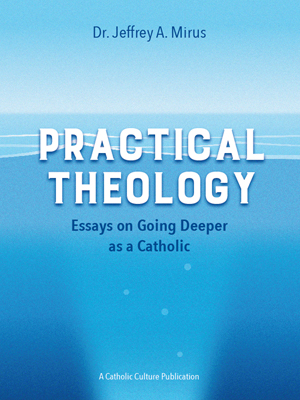Father Gabriel, Detective
By Dr. Jeff Mirus ( bio - articles - email ) | Mar 27, 2017 | In Reviews
Just because I gave up reading mysteries for Lent does not mean you should not be allowed to know of Ignatius Press’ latest foray into the mystery market. The publisher has considerable experience with mysteries, of course, having published works on the mysteries of Our Lady of Guadalupe and the mysteries of relics, not to mention the mystery of the Eucharist, the mystery of death, the mystery of Redemption, the mystery of God and, of course, the Paschal Mystery.
Ignatius has also published Chesterton’s famous Father Brown mystery stories, and even two stand-alone mystery novels by the contemporary author T. M. Doran, one of which I reviewed nearly six years ago. But despite the yearning of contemporary Catholic writers to create a serial mystery hero as popular as Chesterton’s Father Brown, Conan Doyle’s Sherlock Holmes, or Christie’s Hercule Poirot, Ignatius has never committed itself to a mystery series with a Catholic hero...until now.
The first entry in the proposed series is The Sleeping Witness by Fiorella De Maria, a Malta-born novelist who grew up and still lives in England—which as everyone knows is a prerequisite for laying claim to being any sort of writer at all. Her past novels, several published by Ignatius, have been deliberately deeper and more fully developed. (See, for example, Poor Banished Children.) Happily for mystery lovers, De Maria has embarked upon a lighter series of books—if murder and mayhem can be called “lighter”—featuring her new hero, Father Gabriel, a Benedictine with an uncertain future as a religious. Hence what will surely become the hallmark subtitle for each book in the series: “A Father Gabriel Mystery”.
Living and working in an abbey in England not long after World War II, Father Gabriel naturally takes an unwonted interest in those who inhabit the surrounding region, and particularly those who happen to reside in cottages on the abbey grounds. The time and place allow for three aspects of a good mystery story which seem always to attract readers: A stately English setting, an earlier period, and the complexities that arise from experiences in war. In this case, lingering hostilities explode (gruesomely) between two characters, a man and a woman, who had played very different roles in a German concentration camp.
Taking a page from Chesterton’s portrayal of Father Brown, De Maria portrays her own Father Gabriel as a somewhat simple and apparently undisciplined cleric who nonetheless sees things that other people miss. Or perhaps it would be more accurate to say that Father Gabriel intuits the truth about things without always being able to explain why he suspects that people are not as they seem or that the obvious explanation makes no sense.
This borrowing of the main character (changed but clearly derived from Chesterton) must be taken as a strike against the new series, as must Father Gabriel’s inability to explain precisely what triggers his suspicions. Whether these are major strikes must be determined by how well the author develops Father Gabriel as a distinctive character, and by whether she eventually solves the problem of how to deal with clues, a problem which lies at the heart of good mystery. In any case, after this first installment, I find that I do not care nearly as much about Father Gabriel after reading a 172 page novel as I did about Father Brown after reading my first of Chesterton’s short stories.
Nor is De Maria as clever as was Chesterton in demonstrating that special penetration of the human heart which enabled Father Brown to embody, in his own unassuming way, the essential character of the Catholic priest, a character which is always set against the false and even tedious insights of the world. But Chesterton (to say nothing of Conan Doyle or Christie) is a large mountain to scale. In The Sleeping Witness, De Maria does succeed in posing a mystery which keeps the reader interested, and in producing characters which, for the course of the tale at least, are sufficiently well-drawn to amuse, confuse, excite both sympathy and suspicion, and engender a rooting interest.
In making such judgments, it is essential to recall that this is a first effort at serial mystery. Given the range and depth of what we might call De Maria’s true novels, one can expect the recurring characters in her mysteries to deepen even as the series grows in power, if the author perseveres. The Sleeping Witness is good enough to warrant reading more about Father Gabriel as his various adventures appear in print.
After all, mystery lovers are more than willing to cast a broad net; we live in hope of finding another truly gifted fictional sleuth who can entertain us richly for a considerable time. For my part (when Lent is ended, of course), I shall have no trouble living in hope for Fiorella De Maria’s Father Gabriel.
All comments are moderated. To lighten our editing burden, only current donors are allowed to Sound Off. If you are a current donor, log in to see the comment form; otherwise please support our work, and Sound Off!









